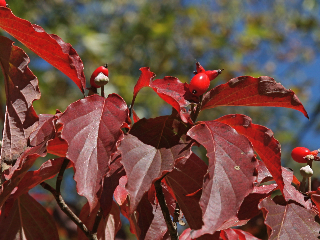 16 October 2008
16 October 2008
Phenology is the study of biological activity patterns through the seasons … or … (my definition) a list of what nature is doing at a particular time of year.
Chuck Tague, who supplies me with beautiful pictures like this one, used to publish a newsletter called The Nature Observer News. The other day I was reminiscing about his bi-monthly list of “What to Look For” that made me eager to get outdoors in every season. I relied on his phenology and now I miss it.
Last week [October 2008] I asked Chuck if he’d consider sending me abbreviated phenologies for southwestern Pennsylvania so I could post them on my blog every month. Happily, he was thinking of publishing The Nature Observer online and said I could piggyback.
[In 2008] Chuck launched his complete list for late October on his new blog, The Nature Observer’s Journal. Here’s the first hint of the treasures Chuck promises in southwestern Pennsylvania in the next two weeks:
- Fall colors reach their peak, especially red and sugar maples.
- First frost around October 20. First hard frost around Halloween.
- It’s hunting season! Wear blaze orange and be aware of Pennsylvania’s hunting seasons. Remember: Though Sunday is generally safer, some game can be hunted on Sundays.
- The first wave of ducks and geese migrate through our area.
- Hawk watches see lots of sharp-shinned and red-tailed hawks.
- Golden eagle migration peaks at the Allegheny Front in the third week of October.
- White-throated sparrows, dark-eyed juncos and American tree sparrows arrive to stay through the winter.
- Big flocks begin to form at dusk and dawn: grackles, robins, starlings and (my favorite) crows.
- Pitt’s peregrines stay active on migration days while food (small birds) and threats (other hawks) fly by.
- Most flowers have gone to seed but watch for blooming witch hazel, bottle gentian, hardy goldenrods and asters.
- By October 31 in Pittsburgh the shorter days will provide only 10.5 hours of sunlight.
- Be prepared to “fall back” on the first Sunday in November when we set our clocks to Standard Time. After that, evening rush hour will be in the dark.
For Chuck’s complete phenology for October, click here.
(photo of Flowering Dogwood by Chuck Tague)
I enjoyed reading “what’s to come” but I don’t like the idea of driving home from work in the dark. I wish we would just leave the time alone.
I am looking forward to having the Junco’s back at my feeder this winter along with the cardinals and the sparrows.
I would like to know if you can recommend a way to keep water out in the winter for the birds so that it won’t freeze.
Thanks as always.
There are two ways to provide water for the birds in winter. One is a heated birdbath (the birdbath itself plugs in), the other is a birdbath heater (something you immerse in the birdbath). You can buy either of these at garden shops and birdseed stores. To see them online, try http://www.birdbath.com
I also use a heated dog dish and put rocks in it so it doesn’t blow away andso it isn’t too deep for the birds…sometimes the birds, esp the song sparrow, will keep trying to get a bath, even with the rocks.
I too am not ready to have more dark than daylight.
I have tried both methods. Both are thermostatically controlled to turn on when the water temp gets below about 42 degrees. First I tried the heater in the birdbath. It worked, but it was a little tricky getting the heater to stay placed properly in the birdbath. Then I wondered how much the electricity cost using the heater. I can’t remember the math now, but I think we concluded about $10 a month. Cheap enuf, but then Candy Gonzales of New Castle recommended the heated dog dish (which you can buy inexpensively at a place like Wal-Mart). She said its electrical cost was cheaper. And it’s easy to use since the heater is built in. The dog dish is quite large and deep, so adding a couple of rocks gives birds something to stand on.
Thank you, I will look into both options. I look forward to taking care of the birds this winter.